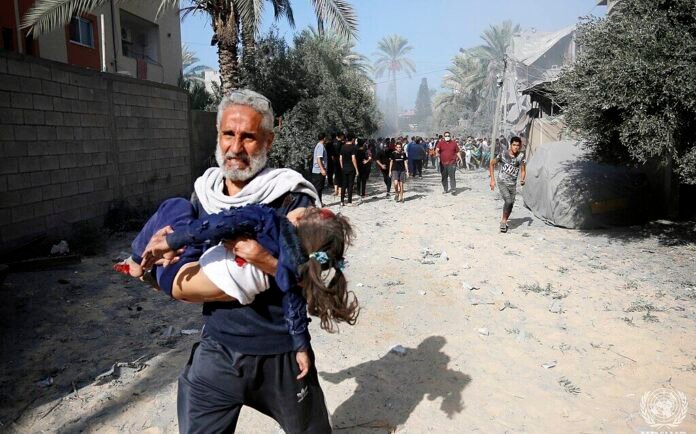Tens of thousands flee northern Gaza as Israeli strikes kill civilians, including women and children
Israel escalated its military offensive in Gaza on Monday, launching a fresh wave of devastating airstrikes that killed around 60 Palestinians, according to local officials and medical workers. The assault came as tens of thousands were forced to flee new evacuation zones in the war-shattered enclave, adding to the already catastrophic humanitarian crisis.
The renewed bombardment coincided with a senior Israeli adviser’s arrival in Washington for ceasefire talks. Ron Dermer, Israel’s strategic affairs minister and a close confidant of Prime Minister Benjamin Netanyahu, is expected to meet US officials to discuss ongoing hostage negotiations with Hamas and the broader regional fallout from Israel’s war on Iran.
Despite diplomatic manoeuvres abroad, the situation on the ground in Gaza has worsened dramatically. On Monday, Israel issued new evacuation orders for northern Gaza, urging residents to move south to overcrowded coastal areas with few resources and little clean water. An estimated 80% of Gaza’s territory is now either under Israeli military control or subject to evacuation orders.
The Israel Defense Forces also signalled their intention to advance deeper into central Gaza City to confront Hamas fighters they say remain embedded there. Tanks and infantry rolled into the Zeitoun neighbourhood on the eastern edge of the city, while artillery pounded multiple districts and warplanes struck several locations, including four schools where hundreds of displaced families had sought shelter.
“In the news we hear a ceasefire is near; on the ground we see death and we hear explosions,” said Salah, a 60-year-old Gaza City resident. “It felt like earthquakes.”
Among the dead were at least 22 people—women, children and a local journalist—killed when an airstrike slammed into a beachside café in Gaza City. Residents said the explosions continued without pause throughout the day, hitting homes, schools, and supposed safe zones.
Embed from Getty ImagesThe Israeli military claimed it targeted Hamas command centres and militant sites in northern Gaza and stated it had taken steps to reduce civilian harm. But eyewitness accounts and the rising civilian toll paint a grimmer picture.
Aid agencies and medical staff described the situation in Gaza as post-apocalyptic. Hospitals are overwhelmed, food and fuel remain in critically short supply, and looting has become widespread as gangs clash over aid deliveries. The war has left Gaza’s infrastructure in ruins, with over 56,500 Palestinians—most of them civilians—killed since the conflict began in October 2023.
On Monday, Nasser Hospital in Khan Younis reported receiving the bodies of 11 people shot while returning from an aid distribution site. Ten others were killed at a UN aid warehouse in northern Gaza, according to the territory’s health ministry. The Israeli military acknowledged that civilians had been harmed while collecting aid and said new instructions had been issued to soldiers following “lessons learned.”
As the violence continues, diplomatic pressure is mounting. Netanyahu is scheduled to visit the United States on 7 July to meet President Donald Trump, who has publicly called for a ceasefire and a deal to free the roughly 50 remaining hostages held by Hamas.
But reaching a deal remains difficult. Hamas demands a total and permanent end to the war and refuses to disarm. Israel, meanwhile, insists it will only halt operations once Hamas surrenders its weapons and leadership.
Inside Israel, the tide of public opinion is shifting. Yair Lapid, the opposition leader, declared that continuing the war no longer benefits the country and instead inflicts political, economic, and security damage. A recent opinion poll revealed that nearly two-thirds of Israelis now want the war to end.
Still, both sides remain entrenched in incompatible positions. For civilians in Gaza, that means more displacement, more death, and no clear end in sight.
